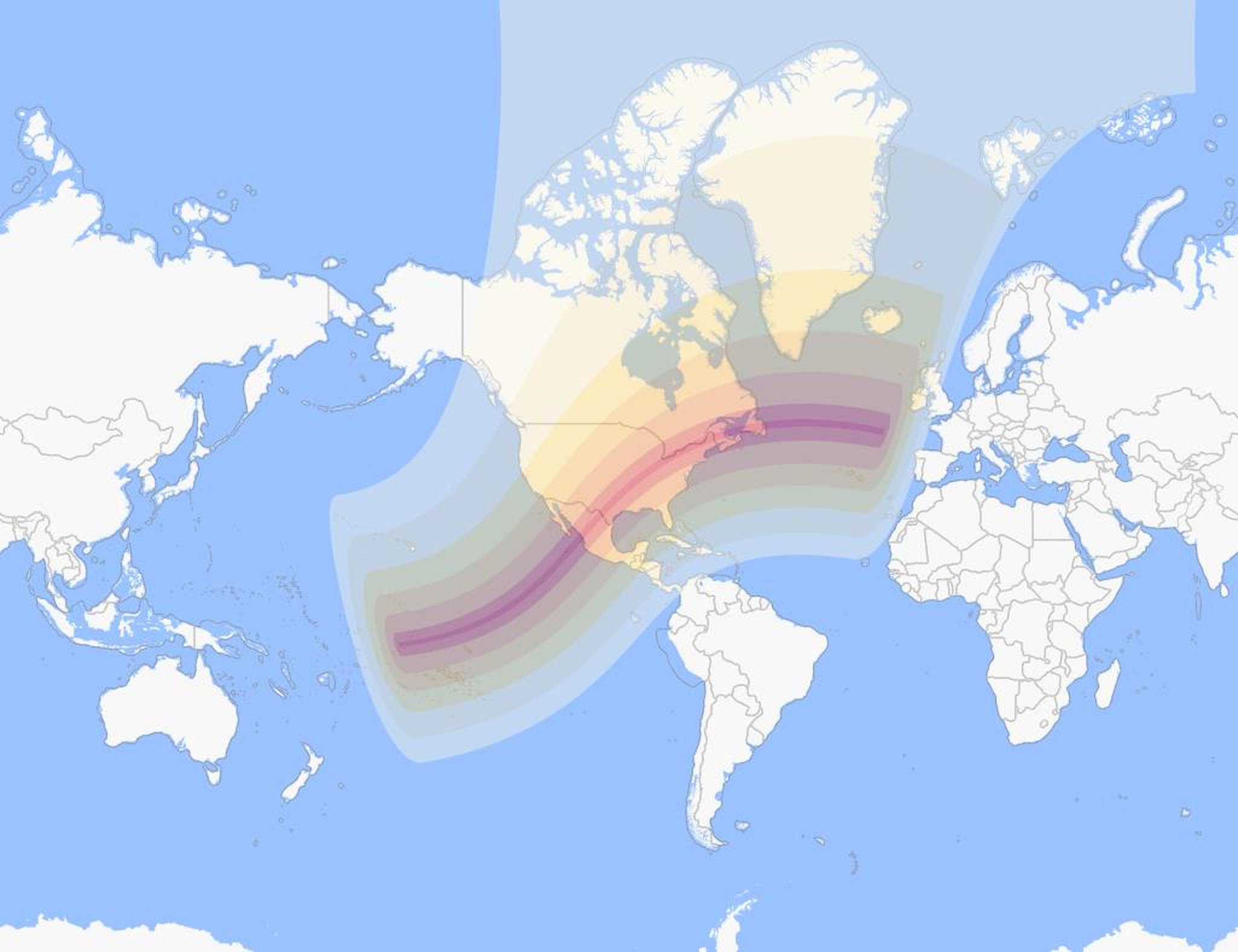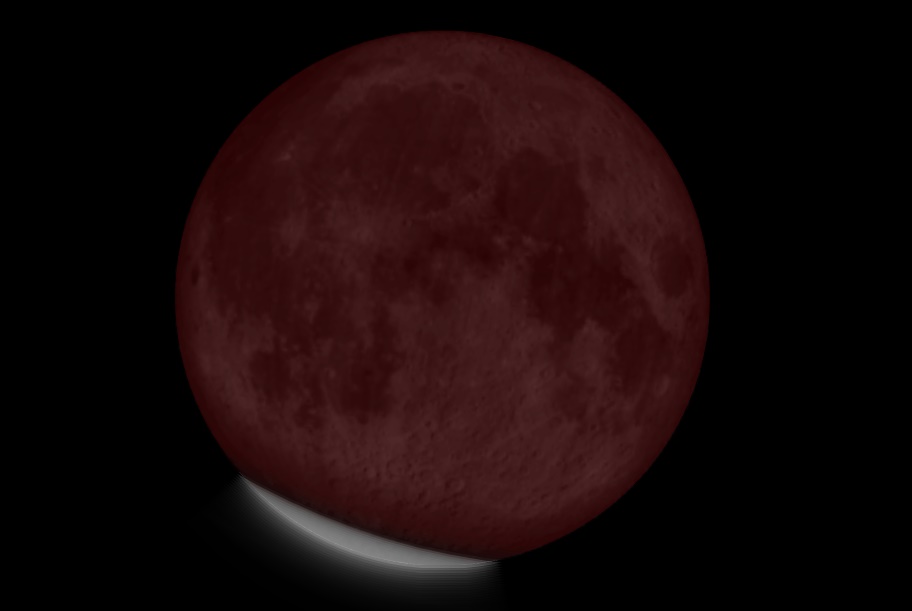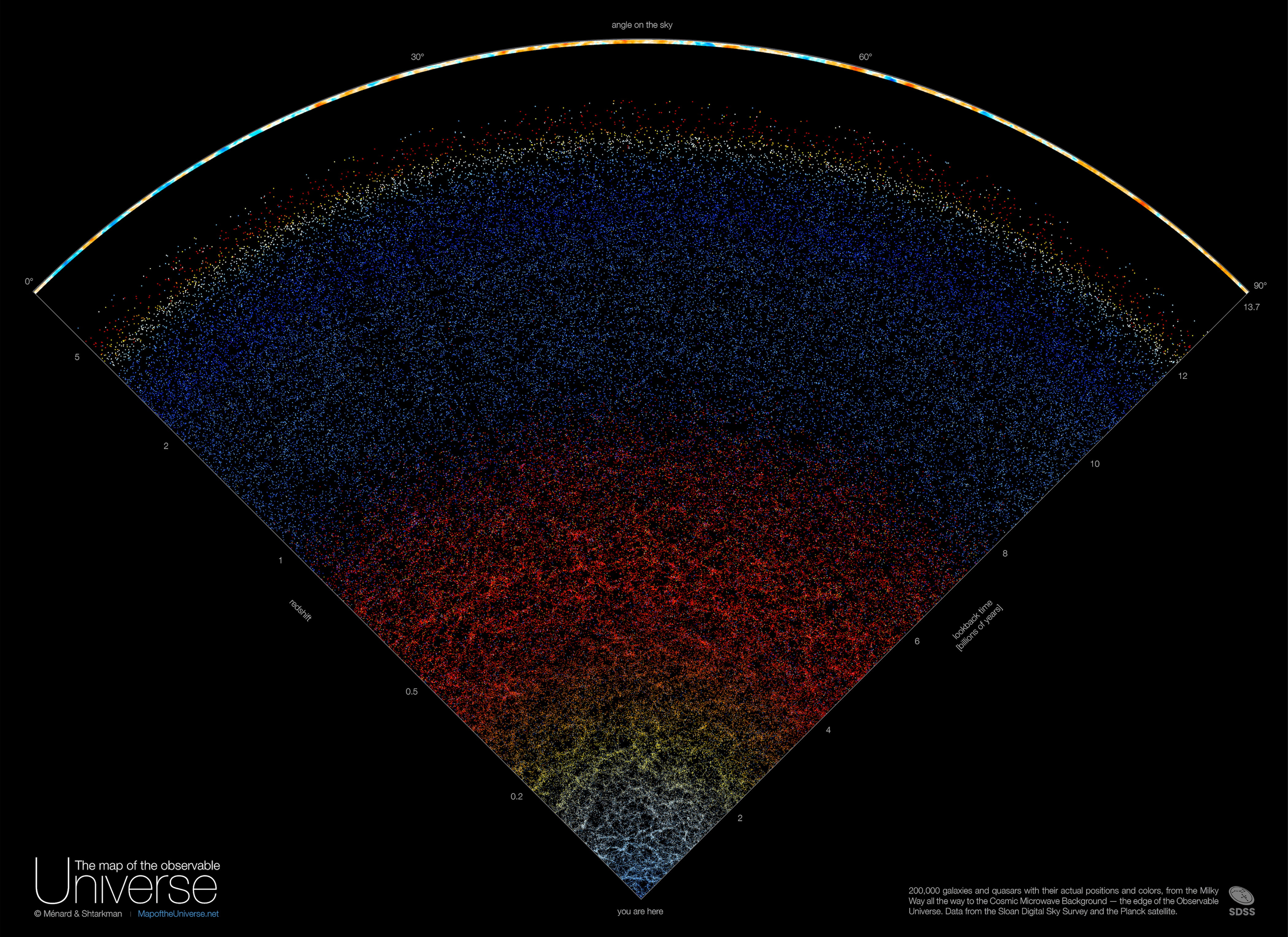October 14, 2023’s annular eclipse will have huge consequences 6 months later
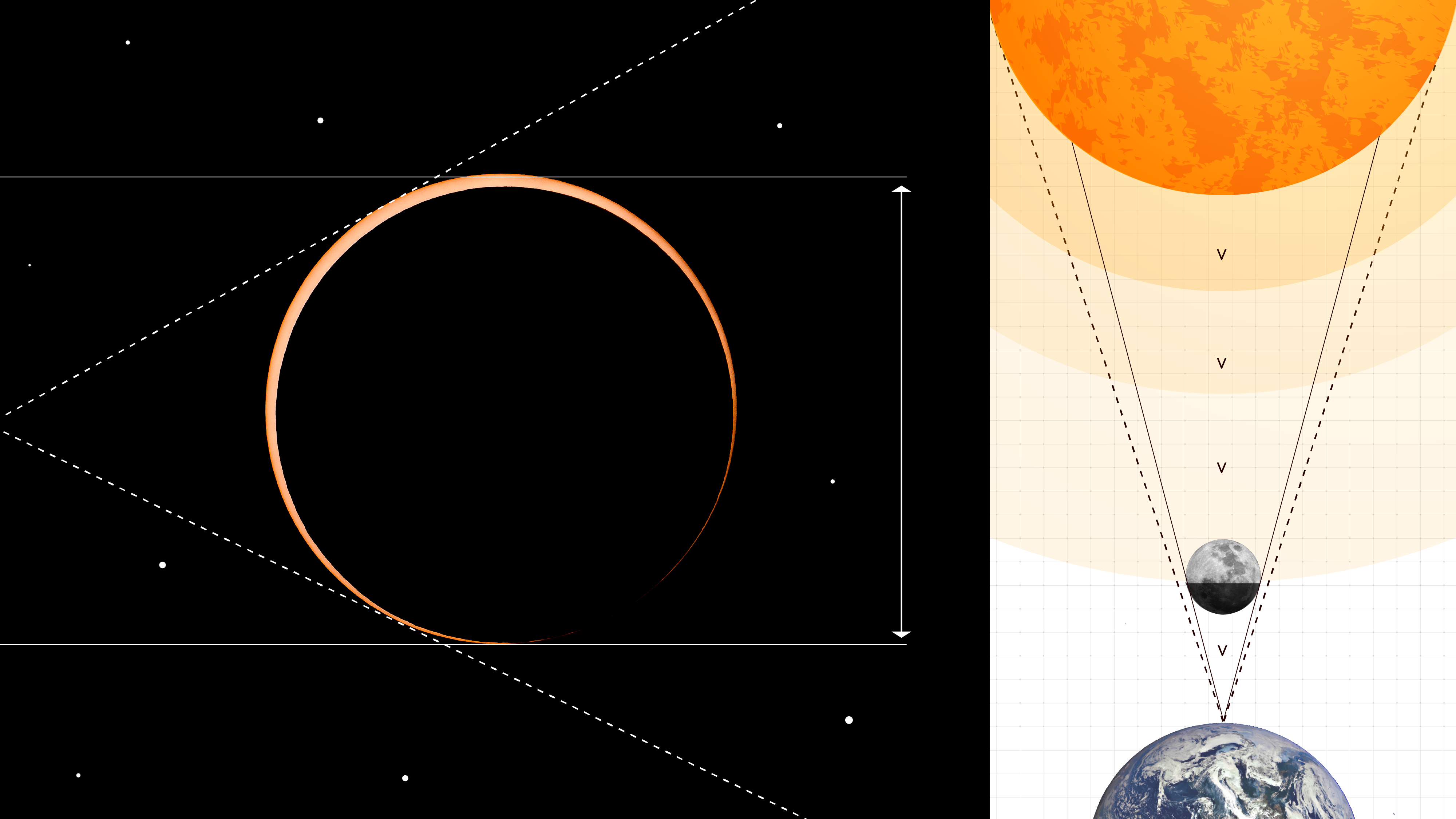
- Only twice a year are the physical conditions favorable for the Sun, Earth, and Moon to all align in space: creating conditions for either solar or lunar eclipses.
- On October 14, 2023, an annular solar eclipse is coming to Earth, as the new Moon will pass in front of the Sun’s disk as seen from our planet.
- Six months later, on April 8, 2024, the next eclipse — a total solar eclipse — will grace our skies. This is the science behind why this happens.
It’s been more than two years since Earth last experienced an annular solar eclipse, with the last one occurring on June 10, 2021, but one will happen on our planet over both North and South America on October 14, 2023. Over the span of a few hours, the Moon’s disk will appear to pass in front of the Sun, blocking out a portion of its light. From a few select locations here on Earth — for observers in what’s called the “path of annularity” — the alignment will be so perfect that the entire Moon, as seen from Earth, will pass in front of the Sun. But because the Moon, at that key moment in time, will be farther than a particular critical distance from the Earth, it will be unable to block the entirety of the Sun’s disk.
Instead, observers on Earth, even with the most perfect alignment possible, will still see a narrow ring, or annulus, of the Sun poking out from all sides around the Moon, creating a gorgeous phenomenon known as a “ring of fire” during this annular eclipse. But don’t despair: this annular eclipse is a signal that just 6 months later — on April 8, 2024 — an even better eclipse, a total solar eclipse, will befall our planet. This is no mere coincidence, but rather is a mandatory consequence of three factors:
- the Moon’s motion around the Earth,
- the Earth’s motion around the Sun,
- and the laws of gravity, which dictate lunar and planetary motion.
With just the law of gravity and the Sun, Moon, and Earth, we can understand why October’s upcoming annular eclipse paves the way for 2024’s great North American eclipse.
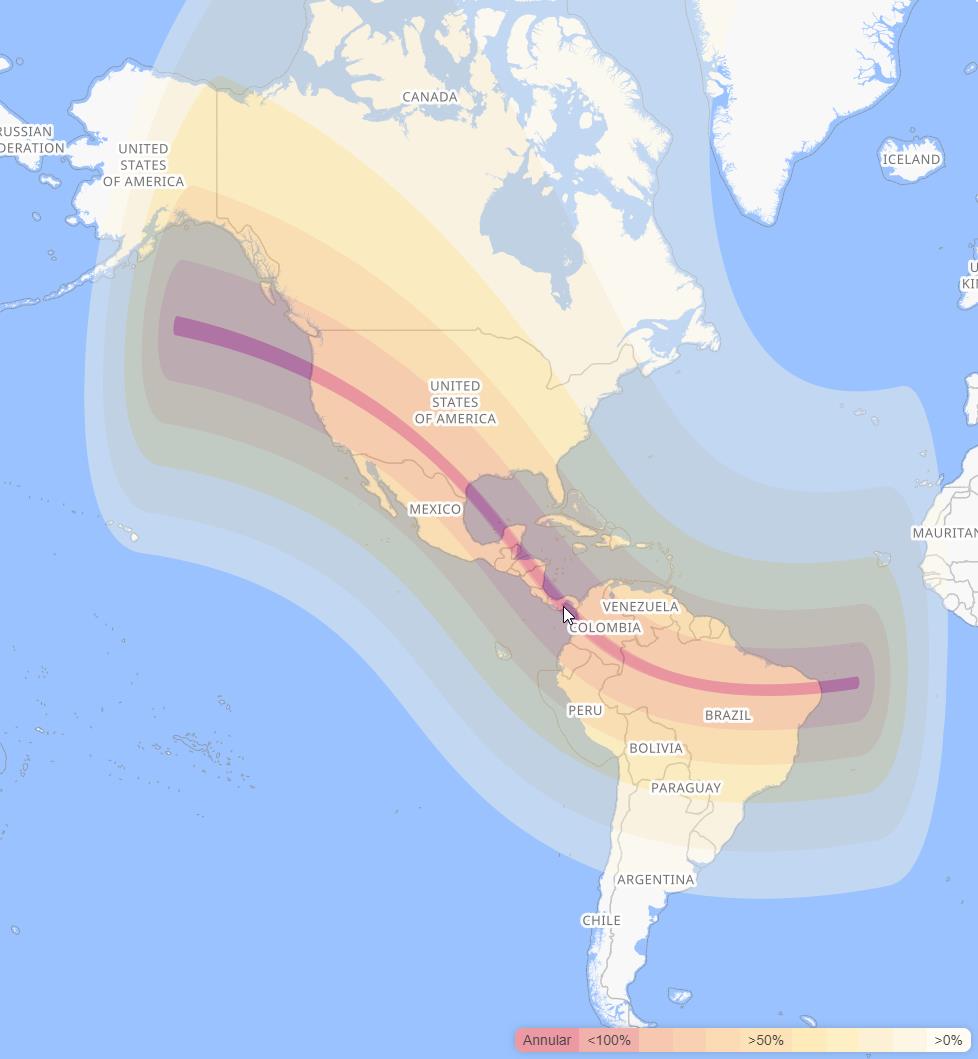
The simplest way to view the Solar System — too simple in many regards — is to treat the Earth as moving in a circular orbit around the Sun, and the Moon as moving in a circular orbit around the Earth, all while the Earth rotates on its axis. This picture explains:
- our 24-hour day, as the spinning Earth experiences daytime when we’re on the Sun-facing side and nighttime when we’re on the side facing away from the Sun,
- the apparent rotation of the stars about one of the celestial poles, as the Earth rotates,
- the phases of the Moon that change throughout each ~29.5-day period, as the visible portion of the Moon that’s illuminated by the Sun changes with respect to Earth as the Moon revolves around us,
- and the seasonal changes throughout the calendar year, as the Earth, rotating on its axis and revolving around the Sun, experiences summer in the hemisphere whose pole is tilted toward the Sun and winter in the hemisphere whose pole is tilted away from the Sun.
However, there’s a problem that comes from these oversimplifications. If this were the way that the Sun, Earth, and Moon worked, then every single lunar month, when the Moon was in its “new” phase, it would pass between the Sun and Earth, creating a solar eclipse, and when the Moon was in its “full” phase, it would dip into the Earth’s shadow, creating a lunar eclipse.
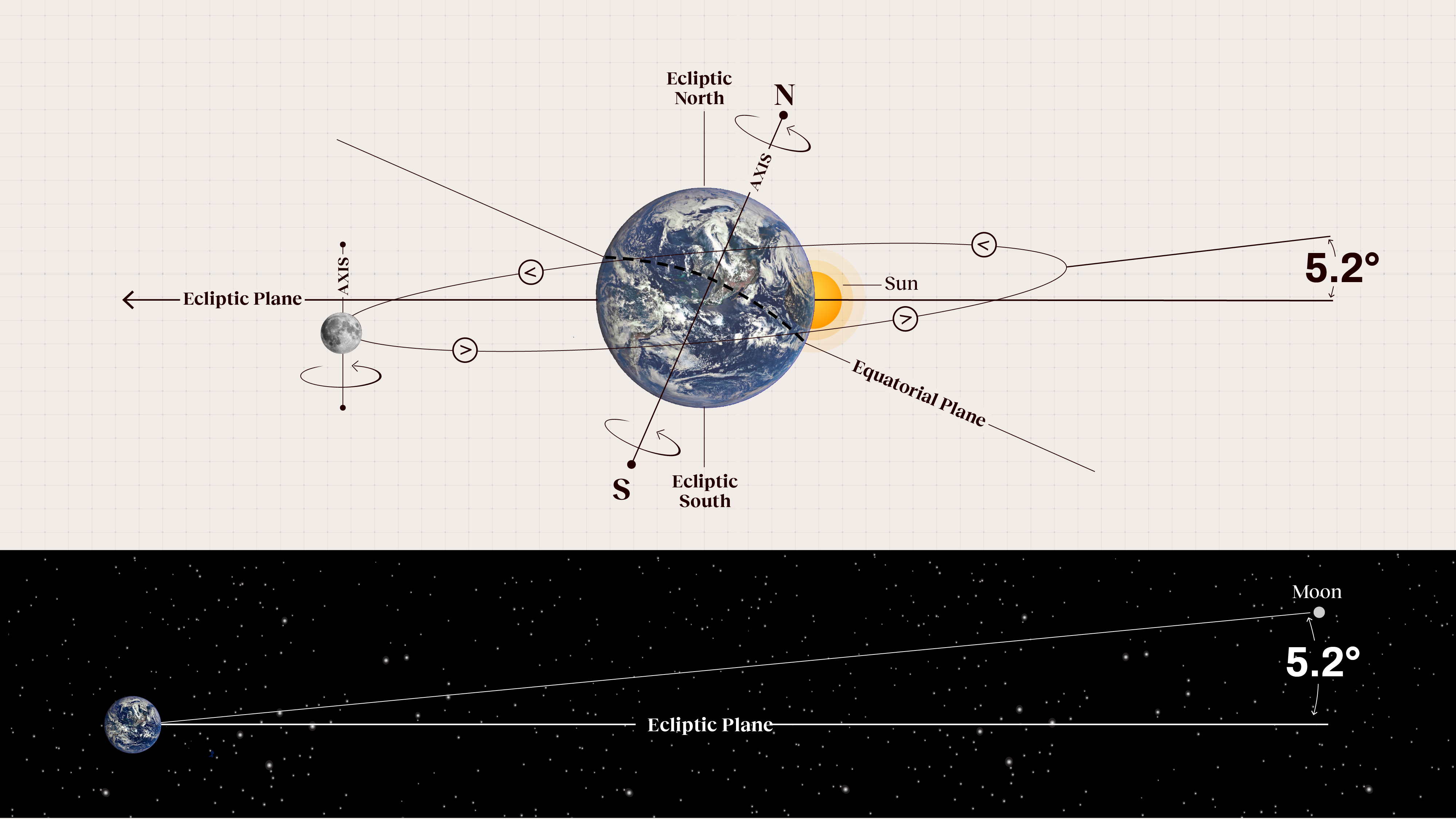
Both solar and lunar eclipses are not only possible, but regularly occur. Only, we don’t get an eclipse twice every lunar month, but only one-to-three eclipses that occur over each of two short intervals of time annually. There’s a good reason for that: the orbital path that the Moon traces out as it revolves around the Earth is not in the same two-dimensional plane that the Earth traces out as it revolves around the Sun. In other words, it is true that the Moon orbits the Earth and that the Earth orbits the Sun, but you can’t draw both orbits on the same flat, two-dimensional sheet of paper!
It’s as though the Earth orbits the Sun in one plane, or on one sheet of paper, and then the Moon’s orbit around the Earth occurs in a different plane, or on another sheet of paper: one that makes a small but important angle relative to the Sun-Earth plane, inclined at about 5.2 degrees. That might seem like a very small angle — and relative to all the possible orientations that two planes could be inclined at, it is a small angle — but it’s quite large compared to the angular size of either the Moon or Sun in the sky, which come in at only about half-a-degree. Relative to the Earth-Sun plane, the Moon is almost always either completely “above” or “below” it, making eclipses impossible during those times.
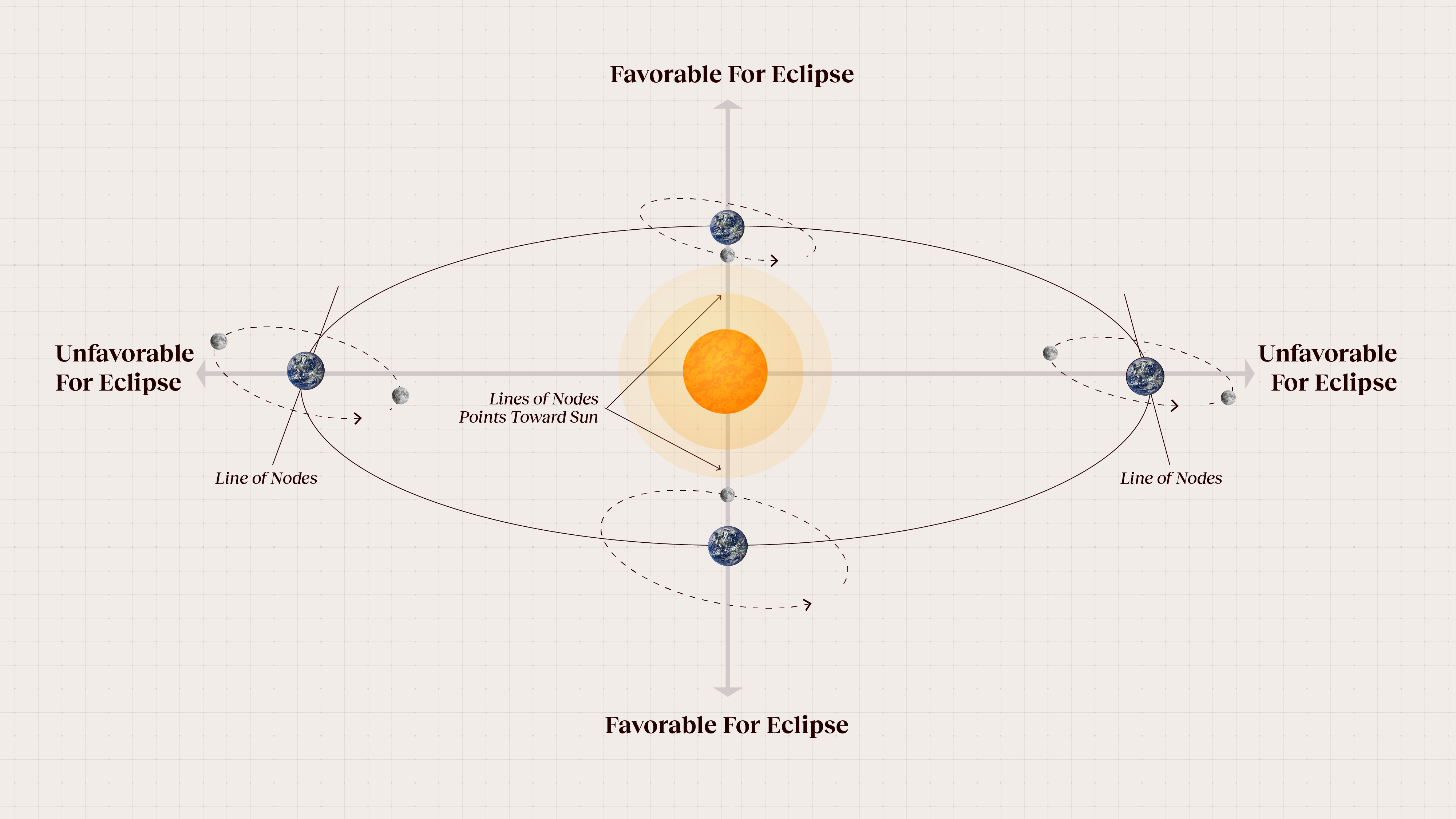
But this is where another important piece of our understanding comes into play: the Moon, orbiting the Earth, maintains that same 5.2° tilt relative to the Earth-Sun plane all throughout the year. During most months, the new Moon phase and the full Moon phase occur with the Moon either well above or well below the Earth-Sun plane, and so eclipses are impossible. The reason is simple: the Moon casts a shadow from the Sun shining on it, but during the new Moon phase, that shadow won’t fall on the Earth with such an imperfect alignment. Similarly, the Earth casts a shadow from the Sun shining on it, but the full Moon won’t pass into that shadow with such an imperfect alignment, either.
However, patience is a virtue here. The Moon, in its orbit around the Earth, will pass in-and-out of the Earth-Sun plane twice every month. And there are two occasions per year — once on either side of the Earth-Sun orbit — where the Moon dips into the Earth-Sun plane during its new and/or full phases. Those events, where the Moon-Earth plane and the Sun-Earth plane line up during the new and/or full phases, are the times of year when conditions are favorable to have an eclipse. If the Moon and Sun are on opposite sides of the Earth from one another (i.e., during a full phase), the conditions are right for a lunar eclipse. And if the Moon and Sun are on the same side of the Earth as each other (i.e., during the new phase), the conditions are right for a solar eclipse.

This explains why eclipses occur when they do. Earlier this year, there was a total solar eclipse on April 20th, followed by a penumbral lunar eclipse (which I count as an “almost” lunar eclipse) two weeks later, on May 5th/6th. Six lunar months later, there’s an annular solar eclipse on October 14th, followed by a partial eclipse on October 28th/29th. That “line of nodes” that the Moon makes with the Earth-Sun orbit lines up in a way that’s favorable for eclipses every six lunar months or so. And that’s why, six lunar months later, there will indeed be another total solar eclipse on April 8th, 2024. (There’s also a penumbral eclipse on March 24th/25th of 2024, and then another six lunar months later, a partial lunar eclipse on September 17th/18th and an annular solar eclipse on October 2nd.)
This pattern continues, roughly every six lunar months: with eclipses only becoming possible when the Moon passes through the Earth-Sun plane at times that coincide with either the Moon’s “new” or “full” phase. Partial eclipses are easy to explain: when the Earth-Sun plane and the Earth-Moon plane are not quite in perfect alignment — when they’re offset by about a quarter of a degree or so — then only either:
- part of the Sun’s disk will be blocked by the Moon as seen from Earth (for a solar eclipse),
- or part of the Moon will fall into the Earth’s shadow (for a lunar eclipse),
and so only a partial, rather than a total (or annular) eclipse will occur.
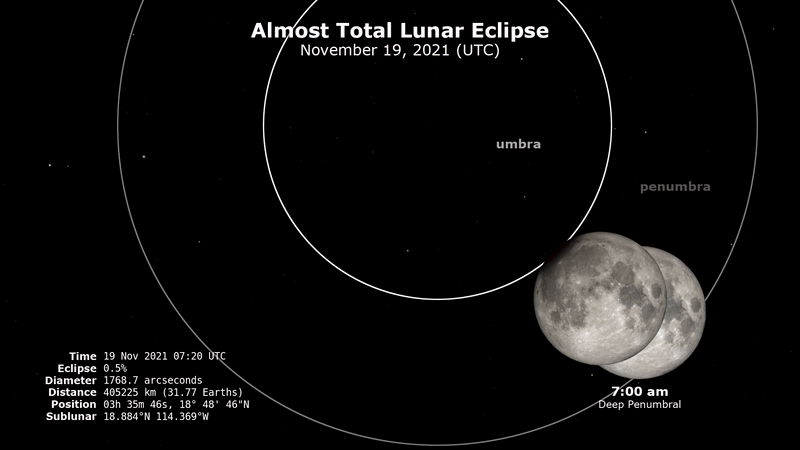
For lunar eclipses, whenever the angular alignment between the Sun, Earth, and Moon is perfect, you’ll always experience a total lunar eclipse. There’s no such thing as an annular lunar eclipse, and for good reason: the Earth is large relative to the Moon. Consider this: if you were an astronaut on the Moon, the Sun would appear to take up about half a degree (0.5°) in your sky. The Earth, however, appears enormous: taking up anywhere between 1.8° and 2.0° in the sky: approximately four times the angular size of the Sun. Whenever the Earth appears to pass in front of the Sun from the perspective of someone on the Moon, it always appears large enough to completely block out the Sun. Therefore, all lunar eclipses on Earth, as long as the alignment is good enough, will be total lunar eclipses.
But that’s not the case at all for solar eclipses. The Moon is much smaller than the Earth: barely more than one quarter of the physical diameter of our planet. From the perspective of an observer on Earth, the Moon and Sun take up approximately the same angular size in the sky: about half a degree (0.5°) as viewed by someone on our surface. In fact, if you were to photograph the Moon every single day (or night) that you could see it from Earth, you would find that, even as the Moon’s phases changed, its apparent overall size in the sky would appear to change as well!
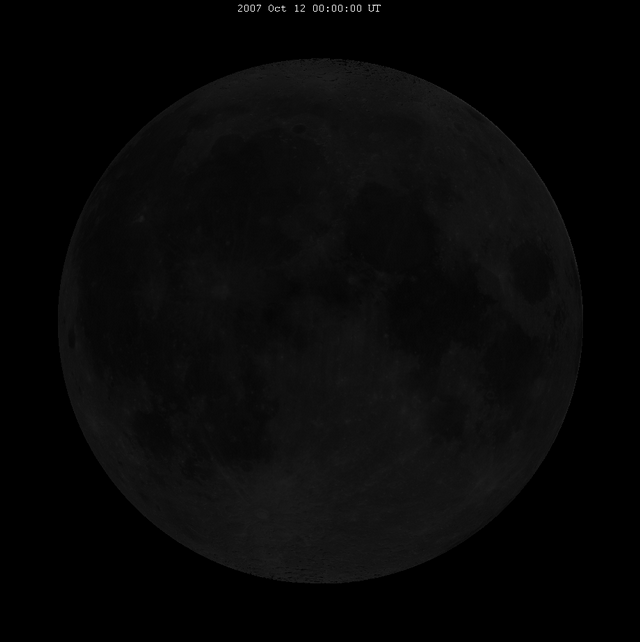
Why does this happen? It’s because the Moon doesn’t make a perfect circle in its orbit around the Earth, but rather makes a rather elliptical shape. At its closest approach to Earth, known as perigee, the Moon is barely 356,000 kilometers distant, causing it to take up about 0.57° in the sky: somewhat more than half-a-degree. At its farthest from Earth, known as apogee, the Moon can exceed 406,000 kilometers in its distance from Earth, where it takes up only 0.49° in the sky. Those might seem like tiny differences, but it’s very important to compare them to the only other important scale that matters for solar eclipses: the angular size of the Sun.
The Sun is physically very huge, but it’s also physically very distant. The Sun, in fact, is about 400 times as large, in terms of diameter, as the Moon, but it’s also approximately 400 times more distant. And just as the Moon makes an elliptical orbit around the Earth, so does the Earth make an elliptical orbit around the Sun. The Earth makes its closest approach to the Sun in early January of every year, known as perihelion, where the Sun achieves its maximum angular size of 0.54° as seen from Earth. And the Earth finds itself at its most distant from the Sun approximately six months later, achieving what we call aphelion in early July, where the Sun achieves its minimum angular size of just 0.52° in Earth’s skies.
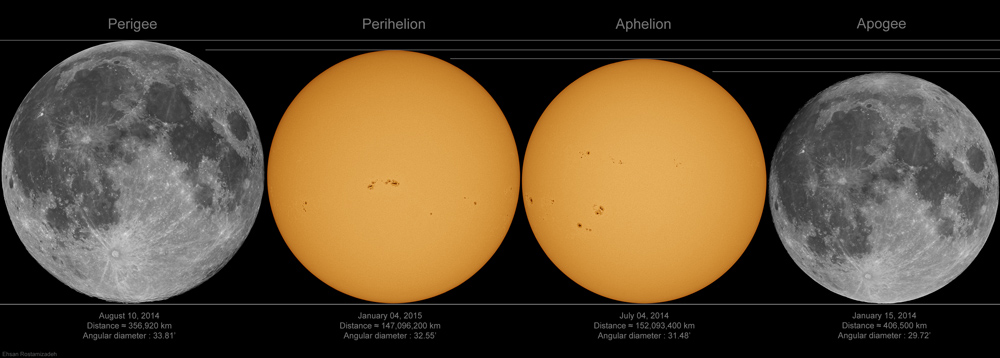
This matters a whole lot! It means, during the new Moon phase when the nodes of the Moon-Earth orbit align with the Earth-Sun plane, that:
- if the Moon’s angular size is larger than 0.54°, you will always have a total solar eclipse on Earth,
- if the Moon’s angular size is smaller than 0.52°, you will always have an annular solar eclipse on Earth,
- and that if the Moon’s angular size is between those values, you can have either a total solar eclipse, an annular solar eclipse, or a hybrid solar eclipse (where some parts of Earth experience a total solar eclipse and other parts experience an annular solar eclipse),
all dependent on the relative angular size between the Sun and the Moon, as seen from Earth, at the critical moment of the eclipse.
In general, you’re more likely to have a total solar eclipse when the Sun is farther from Earth, near aphelion (during the months of May, June, July, and August) and more likely to have an annular solar eclipse when the Sun is closer to Earth, near perihelion (during November, December, January and February). But because the Moon’s orbit varies by a much greater amount than the Sun’s orbit does in terms of their eccentricities and variations in angular size, you can have either a total or annular solar eclipse at any time during the year.
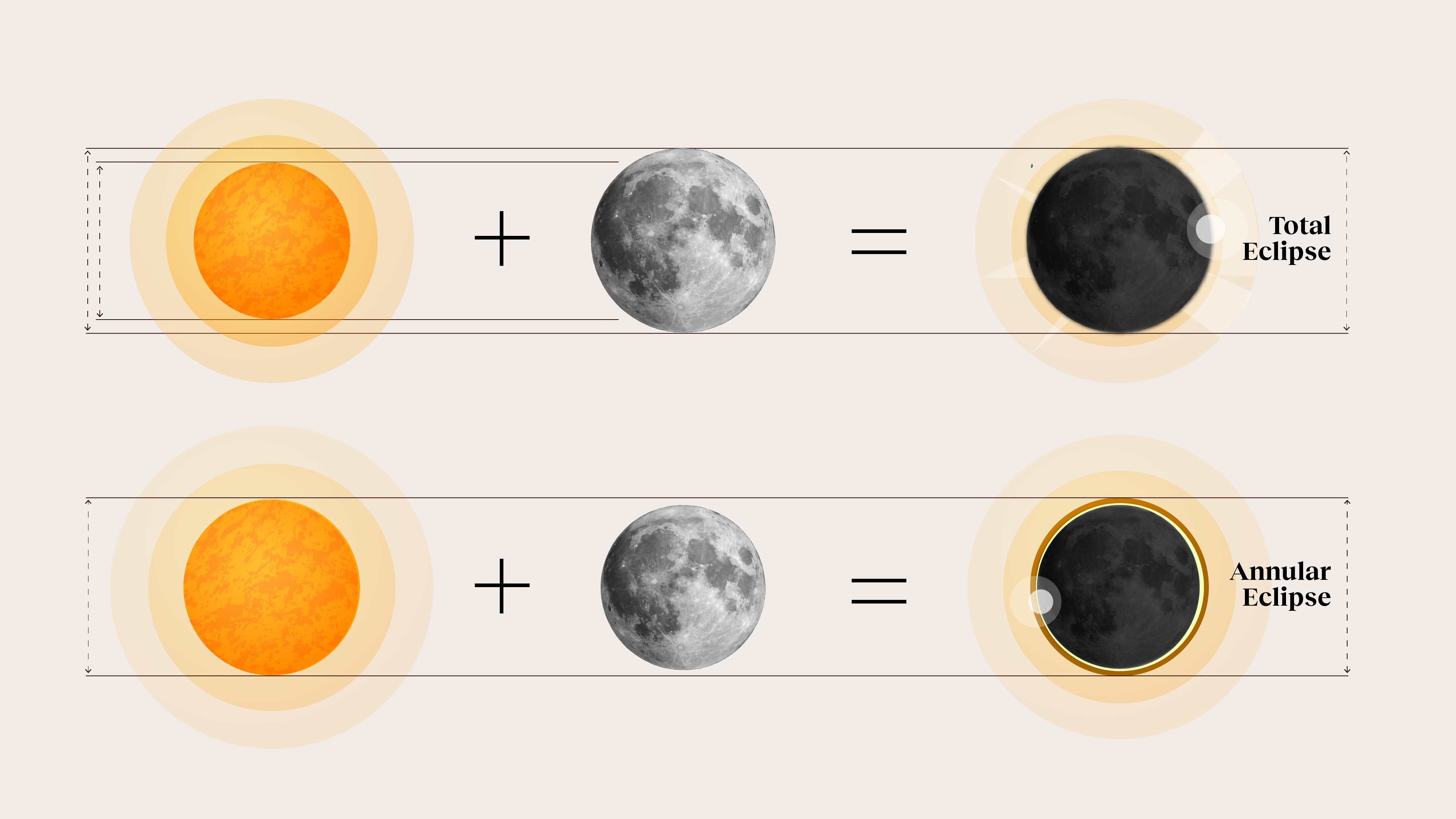
It should come as no surprise to anyone that the longest total solar eclipse of the 21st century occurred on July 22nd, 2009: very close to the Sun’s aphelion and also coincident with a perigee (closest approach) Moon. With the Moon’s angular size so much bigger than the Sun’s, when the Moon completely blocked the disk of the Sun, it did so for a magnificent 6 minutes and 39 seconds. Under ideal, perfect conditions, which never occur in practice, a perigee new Moon would coincide with the Sun’s aphelion from Earth, and the total phase of the eclipse would last up to 7 minutes and 32 seconds.
But what might surprise you is that just 6 months later, on January 15th, 2010, the longest annular solar eclipse of the 21st century occurred. With the Sun at perihelion and the Moon almost perfectly at apogee (its farthest distance from Earth), the Moon’s angular size was at its smallest while the Sun’s was at its largest. Because the Moon is smaller, in angular size, than the Sun, the entire disk of the Moon is capable of fitting into the disk of the Sun. On January 15th, 2010, it remained there — with the illuminated part of the Sun having a ring-like shape known as an annulus — for 11 minutes and 8 seconds. The longest possible duration of an annular eclipse is 12 minutes and 29 seconds.

It’s impressive to know that an annular solar eclipse occurring in October of this year will lead to a total solar eclipse occurring six months later, in April of next year. But for the most spectacular example of what’s ahead in our near future, look ahead to 2027 and 2028.
- On February 6, 2027, Earth will experience an annular solar eclipse, with an apogee new Moon and close to the Sun’s perihelion, with a “ring of fire” phase that lasts nearly 8 full minutes.
- Then, six months later, on August 2, 2027, Earth will experience the longest total solar eclipse remaining in the 21st century, as a near-perigee new Moon eclipses a near-aphelion Sun, creating a totality phase that lasts 6 minutes and 23 seconds.
- And then, another six months after that, on January 26, 2028, another annular solar eclipse occurs, with this one having an annular phase that lasts an impressive 10 minutes and 27 seconds.
After those events, the next total solar eclipse lasting 6 minutes or more won’t occur until 2045; the next annular eclipse lasting 10 minutes or more won’t happen until the year 2131!
If you live in North America, you may have seen the total eclipse of 2017; during the 2024 total eclipse, which lasts more than 2 minutes longer during totality, the skies will get darker, the Sun’s corona will be more visible, and — as a bonus — the planet Venus will be prominent during the eclipse: just to the west of the Sun. You can get the full guide to 2024’s total eclipse here, but know that simply coming six lunar months after an annular solar eclipse is all it takes to set the stage for an even more spectacular possibility to occur!
